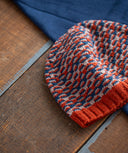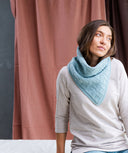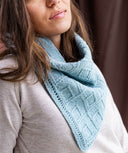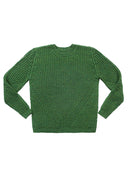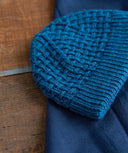Reading Your Knitting 102
In Reading Your Knitting 101, we began the conversation with growing into your craft by returning to the basics — learning to tell your knit stitches from your purl stitches. In this second installment of the series, we’ll talk about how to identify decreases and increases.
Decreasing and increasing in knitting are ways of shaping knitted fabric seamlessly, by either “subtracting” stitches from or adding stitches to the ones already on your needles while maintaining the integrity of your fabric — without dropping live stitches or casting on mid-row. Such maneuvers manipulate the width of your work — “subtract” stitches and your row(s) will be narrower; add stitches and your row(s) will be wider.
You’ll often see decreases and increases used to shape the crown of a hat, the edges of a shawl, the body and sleeves of a sweater, and so forth. Read on to learn how to spot them quickly and intuitively in your knitting!
Decreases
The techniques involved in decreasing your stitches as you’re working a row or round are often as simple as treating multiple stitches like one stitch. The most common example of this is the “Knit 2 Together” (or “k2tog”), where you knit into two stitches at the same time, treating them as if they were one stitch.
There are many decreasing techniques, varying in their complexity, the number of stitches they “subtract” from your row or round, and in their visibility or invisibility in your work. However, the most important thing to remember when you’re working on how to spot them is this: your stitches stack on top of each other to form vertical columns (whether columns of knit V’s, purl bumps, or a mix of both). When you decrease stitches, whether it’s by one stitch or more, the columns of stitches in your work will converge.
So, simply trail your eyes up along the columns of stitches in your work, and when you see multiple columns converging into one column before continuing along upwards, you’ll know stitches were decreased at that spot where the columns converged.
Another thing to keep in mind is that some decreases are directional, meaning that they are performed in such a way that the resulting decrease stitch either leans to the right or to the left.
IN DEPTH
The decreases used in particular areas of a shaped accessory or garment are choices made by designers for functional effect, decorative effect, or both. For example, you’ll often see both right-leaning and left-leaning decreases used in opposing sides of a fabric for symmetry (like armholes or raglan shoulder shaping). You’ll also often see right-leaning decreases used decoratively on the edges of the fabric that slant to left (the opposite way), and vice versa.
In our patterns, we always point out in which direction a particular decrease stitch leans. Keeping the directionality of a particular decrease stitch in mind will also aid you in identifying, not only whether a stitch was decreased in your work, but also which decrease stitch was performed.


As shown in the examples of the “Knit 2 Together” above, the columns of knit stitches (or V’s) converge at decrease points that lean to the right.


Conversely, in the examples of the “Slip, Slip, Knit” above, the columns of knit stitches (or V’s) converge at decrease points that lean to the left.
Increases
Stitch increasing techniques often involve either creating a new stitch between two existing stitches on your needle, or creating multiple stitches out of one stitch. Like decreasing stitches, the techniques used to increase or add stitches to your row or round can vary in complexity, the number of stitches they add, and their visibility or invisibility in your work.
But again, keeping in mind that your stitches form vertical columns, all you’ll need to remember is that when you increase stitches, whether it’s by one stitch or more, the columns of stitches in your work will branch out.
Simply trail your eyes up along the columns of stitches in your work, and when you see one column forking out into additional columns before continuing along upwards, you’ll know stitches were increased at that point where the columns branched out.
Like decrease stitches, increases can also be directional; you can create additional stitches either next to or branching out of the right leg of a stitch (right-leaning), or vice versa (left-leaning). In our patterns, we always point out in which direction a particular increase stitch leans. Keeping the directionality of a particular increase stitch in mind will also aid you in identifying, not only whether a stitch was added to your row, but also which stitch increase was performed.


As shown in the examples of the “Invisible Increase Right” above, one column of knit stitches (or V’s) has branched out into two, with the new column growing to the right.


Conversely, in the examples of the “Invisible Increase Left” above, the new column is growing out to the left.
Application
If you’ve ever worked a sweater pattern that instructed you to increase or decrease at the left and right edges of the sweater body every 16 rows, you may be familiar with keeping tally marks of every row you complete before the next increase or decrease row. If you familiarize yourself with what happens visually when you increase or decrease stitches, you can simply take a look at your work, find the points at which your columns of stitches branch out or converge, and count rows from there.
NOTE
When decreasing, the stitch right above the point where your columns converge marks your decrease row. When counting how many more rows have been added after a decrease row, make sure you start counting from above that row — the “second” row above the convergence point.
Similarly, when increasing, the stitch immediately above the point where your rows branch out marks your increase row. When counting how many more rows have been added after an increase row, make sure you start counting from above that row.
As with reading knits and purls to keep track of pattern motifs and readily catch and problem-solve mishaps in your work, learning to read your increases and decreases will help you keep an eye on what shaping techniques are involved in your work, how they direct your fabric, and at what rate they occur. It’s another step in developing knitter’s intuition and self-reliance in your craft — another legend in the map that is your fabric. Go forth and explore!



